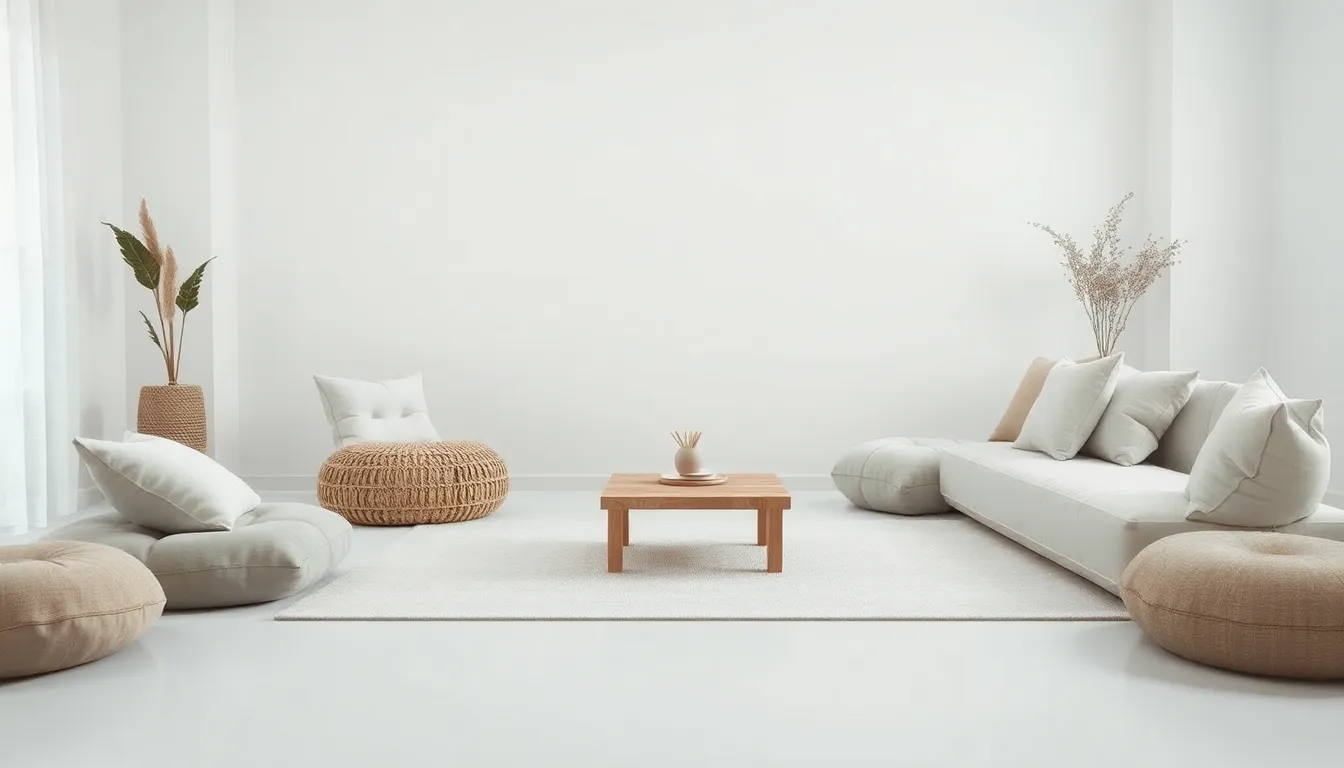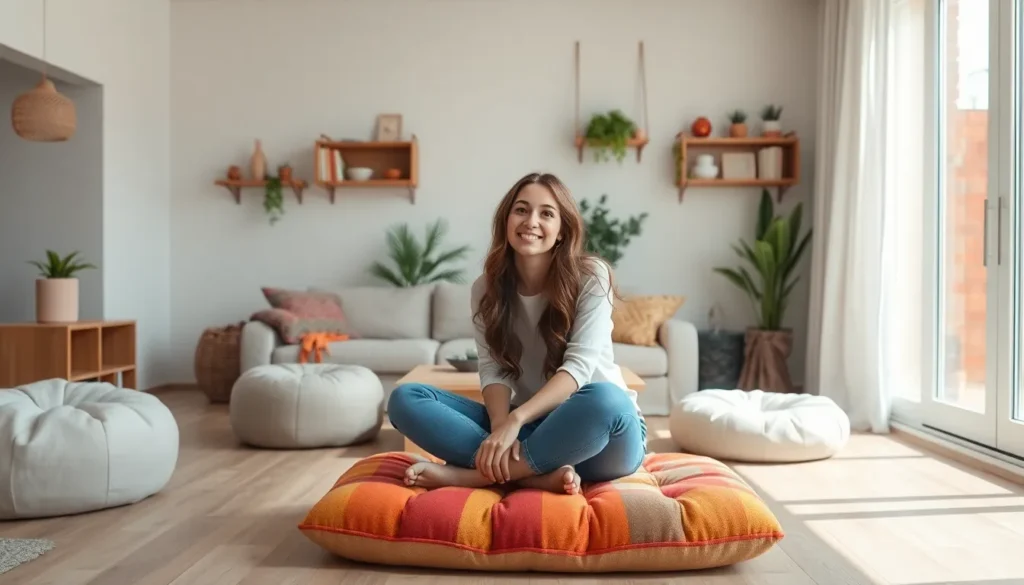In a world where clutter reigns supreme, the minimalist living room without a sofa is like a breath of fresh air—or a well-placed yoga mat. It’s not just about ditching that bulky couch; it’s about embracing a lifestyle that values simplicity and creativity. Imagine a space where every piece has a purpose, and your guests can’t help but admire your bold design choices.
Who needs a sofa anyway? With clever seating alternatives like floor cushions or poufs, you can create a cozy vibe without sacrificing style. Plus, it’s a great conversation starter—who wouldn’t want to discuss their revolutionary seating arrangement? Embracing this unique approach can transform your living area into a chic, functional haven, proving that less really is more. So, let’s dive into the world of minimalist living rooms and discover how to create a stylish space that’s as inviting as it is innovative.
Table of Contents
ToggleUnderstanding Minimalist Living Room Concepts
Minimalist living rooms prioritize simplicity and functionality. This design approach eliminates unnecessary items, focusing on clean lines and open spaces.
Principles of Minimalism
Minimalism centers on reducing clutter and embracing essential elements. Prioritizing quality over quantity enhances overall aesthetics. Clear spaces promote mental clarity and tranquility, allowing for a peaceful environment. Intentionality in decor choices contributes to a cohesive look. Each piece should serve a purpose, whether it’s visual interest or comfort. Natural light often plays a crucial role in these settings, promoting an airy atmosphere.
Benefits of a Sofa-Free Space
Opting for a sofa-free living room offers unique advantages. Flexibility in seating arrangements allows for various configurations to suit occasions. Floor cushions and poufs provide comfort while encouraging a relaxed ambiance. Moving furniture becomes simple, making it easy to adapt to changing needs. A spacious feel emerges from the absence of bulky furniture. This arrangement also permits creative expression through diverse textile choices. Additionally, maintaining cleanliness becomes more manageable, as fewer items accumulate dust and debris.
Essential Elements of Minimalist Living Rooms

Minimalist living rooms rely on carefully selected elements that create a serene atmosphere without traditional sofas. These essential components reflect simplicity, functionality, and style.
Choosing the Right Furniture
Selecting versatile furniture plays a critical role in a minimalist living room. Opt for low-profile seating options like floor cushions or poufs that can easily be rearranged. Incorporate small coffee tables made of natural materials to maintain an uncluttered feel. Prioritize furniture with clean lines and smooth edges, as they enhance the sense of space. Multi-functional pieces serve dual purposes, maximizing utility while minimizing clutter. This selection not only optimizes the layout but also invites comfort without overwhelming the room.
Color Palette and Textures
A cohesive color palette contributes significantly to the overall minimalist aesthetic. Neutral tones such as whites, beiges, or soft grays create a calm backdrop. Introducing subtle pops of color through cushions or decorative accents adds warmth without distraction. Emphasize texture to enrich the visual interest, using materials like cotton, linen, or wood, each adding depth. Contrast different textures in textiles, rugs, and wall treatments to prevent monotony while retaining simplicity. This combination ensures a balanced and inviting living area that embodies minimalist principles.
Creative Alternatives to Sofas
Exploring alternatives to sofas can create a stylish and inviting minimalist living room. Innovative seating options enhance both comfort and space efficiency.
Floor Cushions and Bean Bags
Floor cushions and bean bags offer flexible seating arrangements. They provide comfort while encouraging a relaxed atmosphere. Available in various sizes, colors, and patterns, these options allow for personal expression. Users can arrange cushions to fit their space, achieving functional versatility. Bean bags easily adapt to different activities, making them ideal for casual gatherings or quiet reading. Additionally, they require minimal maintenance, reducing clutter in the living area.
Low-Profile Seating Solutions
Low-profile seating solutions, such as ottomans and simple benches, contribute to an open environment. These furnishings enhance floor space by eliminating bulky designs. An ottoman can double as a table or extra seating, maximizing utility. Similar to benches, these pieces encourage creativity in layout and aesthetics. It’s important to choose materials like wood or metal that align with minimalism. Selecting neutral colors maintains the calm ambiance typical of minimalist design.
Maximizing Space and Functionality
Maximizing space and functionality in a minimalist living room without a sofa involves innovative strategies. Designers prioritize smart designs that promote organization and elegance.
Smart Storage Solutions
Effective storage solutions play a critical role in achieving a clutter-free environment. Wall-mounted shelves allow for easy access to books and decor without taking up floor space. Utilizing baskets and trays can discreetly store items while adding texture to the room. A sleek console table not only holds essentials but also provides hidden compartments for tools or games. Integrating storage ottomans serves dual purposes, offering seating while concealing items inside. Each of these options enhances the overall functionality and helps maintain the room’s aesthetic.
Multi-Functional Furniture Options
Multi-functional furniture adds versatility and practicality to a minimalist living space. Folding chairs can be tucked away when not in use, minimizing clutter while accommodating guests. Nesting tables provide surface area without overwhelming the layout; they can stack together or be spread out as needed. Daybeds serve as both seating and sleeping options, offering comfort without occupying the same space as a conventional sofa. Additionally, simple benches can provide storage and seating, ensuring flexibility within the room. Embracing these options enriches the minimalist design while emphasizing utility and style.
Embracing a minimalist living room without a sofa opens up a world of creativity and functionality. By prioritizing versatile seating options and maintaining a clutter-free environment, individuals can create a space that feels both inviting and stylish. The focus on simplicity allows for a serene atmosphere that enhances mental clarity and promotes relaxation.
With carefully chosen elements and a cohesive color palette, a sofa-free living room can reflect personal style while maximizing utility. This approach not only encourages innovative design but also simplifies maintenance, making it easier to enjoy a peaceful and aesthetically pleasing environment. Ultimately, minimalism proves that a little can go a long way in transforming living spaces into true havens.

